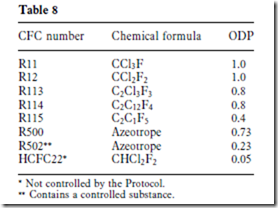The Montreal Protocol
Once the effects of CFC gases on the ozone layer were fully appreciated, leading industrialized countries negotiated a common policy to limit the use of these gases. The term CFC is short for chlorofluorocarbon and refers to a number of compounds developed in the late 1920s. These compounds have a range of qualities to enable them to be used as refrigerants. The term HCFC is short for hydrochlorofluorocarbon and the term HFC is short for hydrofluorocarbon.
The Montreal Protocol as it is now known was signed by 49 countries in September 1987. This international agreement which came into force in January 1989 imposed restrictions upon manufacturers of CFCs.
The main features of the Protocol are:
1 Six months after coming into force in mid-1989 consumption should not exceed 1986 levels.
2 By 1 July 1993 consumption should not exceed 80% of 1986 levels.
3 By 1 July 1998 consumption should not exceed 50% of 1986 levels. The controlled substances are:
CFCs 11, 12, 113, 114, and 115. This will also affect CFC 500 which is a blend of CFC 12 and CFC 115.
When a CFC gas is prefixed by the letter R it denotes that the CFC is being used as a refrigerant.
The greenhouse effect
The infrared energy radiated from the earth’s surface by other atmospheric gases is reflected by dense molecules of the greenhouse gases in the upper atmosphere being retained in the atmosphere. The retention of this energy in sufficient quantity will result in global warming. An increase in world temperature of only a few degrees will produce dramatic climatic changes and a rise in sea levels.
CFCs are known to account for some of this problem, but less when compared with other greenhouse gases such as carbon dioxide which is recognized as the greatest contributor.
![]()
![]() Carbon dioxide accounts for 50 60% of greenhouse gases. Methane, the next ranking contributor at 10 20%, is largely the product of normal natural processes, for example marsh gas, and is more difficult to control.
Carbon dioxide accounts for 50 60% of greenhouse gases. Methane, the next ranking contributor at 10 20%, is largely the product of normal natural processes, for example marsh gas, and is more difficult to control.
Ozone deplet on
Scientists believe that an increase of ultra violet light reaching the earth is associated with skin cancers. Plants are sensitive to sunshine and too much UV light could destroy them and most at risk are cereals. Scientific research has also established that UV radiation levels have a serious effect on Antarctic phytoplankton. Any drastic reduction of these single cell plants will be breaking the first link in the food chain for all southern oceans.
In addition to the CFCs used as refrigerants aerosols came under scrutiny and now contain environmentally ‘friendly’ substances.
It could be said that refrigerators and commercial refrigerating equipment are a major contributor. It is more difficult to legislate against the use of CFCs in these appliances than to ban their use in aerosols. It is not as simple as just replacing the CFC with an alternative ‘safe’ substance. The amount of CFCs released to the atmosphere from refrigerators is small in comparison to that from commercial refrigerating equipment. The real problem is related to leakages in the systems and during servicing when old units are scrapped for whatever reason. Today there is a code of practice to follow and harmful gases must be reclaimed. This puts a greater responsibility upon the service and installation engineer.
Refrigeration vapour compression systems have in recent years been designed and installed for refrigerants R12, R22 and R502. These have now been replaced and the reason for this is the ozone depletion potential (ODP) of these refrigerants. Various refrigerant suppliers have published information in respect of ODP rates and examples are given in Table 8.
HCFC22 offered a solution for replacing the CFCs in a great number of refrigeration systems in the short term, its use being permitted for service and maintenace after it was banned from use in new equipment.
